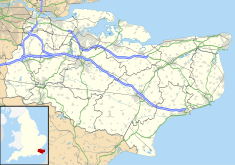| Sissinghurst Castle Garden | |
|---|---|
 Aerial view in 2009: "The most famous twentieth century garden in England"[1] | |
| Type | Garden |
| Location | Sissinghurst |
| Coordinates | 51°06′57″N 0°34′53″E / 51.1157°N 0.5815°E |
| Restored by | Vita Sackville-West and Harold Nicolson |
| Governing body | National Trust |
| Official name | Sissinghurst Castle |
| Designated | 1 May 1986 |
| Reference no. | 1000181 |
Listed Building – Grade I | |
| Official name | West Range at Sissinghurst Castle |
| Designated | 9 June 1952 |
| Reference no. | 1346285 |
Listed Building – Grade I | |
| Official name | Tower and Walls 30 yards East of the West Range at Sissinghurst Castle |
| Designated | 9 June 1952 |
| Reference no. | 1084163 |
Listed Building – Grade II* | |
| Official name | The Priest's House at Sissinghurst Castle |
| Designated | 20 June 1967 |
| Reference no. | 1346286 |
Listed Building – Grade II* | |
| Official name | The South Cottage |
| Designated | 20 June 1967 |
| Reference no. | 1084164 |
Sissinghurst Castle Garden, at Sissinghurst in the Weald of Kent in England, was created by Vita Sackville-West, poet and writer, and her husband Harold Nicolson, author and diplomat. It is among the most famous gardens in England and is designated Grade I on Historic England's register of historic parks and gardens. It was bought by Sackville-West in 1930, and over the next thirty years, working with, and later succeeded by, a series of notable head gardeners, she and Nicolson transformed a farmstead of "squalor and slovenly disorder"[2] into one of the world's most influential gardens. Following Sackville-West's death in 1962, the estate was donated to the National Trust. It was ranked 42nd on the list of the Trust's most-visited sites in the 2021–2022 season, with over 150,000 visitors.
The gardens contain an internationally respected plant collection, particularly the assemblage of old garden roses. The writer Anne Scott-James considered the roses at Sissinghurst to be "one of the finest collections in the world".[3] A number of plants propagated in the gardens bear names related to people connected with Sissinghurst or the name of the garden itself. The garden design is based on axial walks that open onto enclosed gardens, termed "garden rooms", one of the earliest examples of this gardening style. Among the individual "garden rooms", the White Garden has been particularly influential, with the horticulturalist Tony Lord describing it as "the most ambitious ... of its time, the most entrancing of its type."[4]
The site of Sissinghurst is ancient and has been occupied since at least the Middle Ages. The present-day buildings began as a house built in the 1530s by Sir John Baker. In 1554 Sir John's daughter Cecily married Thomas Sackville, 1st Earl of Dorset, an ancestor of Vita Sackville-West. By the 18th century the Baker's fortunes had waned, and the house, renamed Sissinghurst Castle, was leased to the government to act as a prisoner-of-war camp during the Seven Years' War. The prisoners caused great damage and by the 19th century much of Sir Richard's house had been demolished. In the mid-19th century, the remaining buildings were in use as a workhouse, and by the 20th century Sissinghurst had declined to the status of a farmstead. In 1928 the castle was advertised for sale but remained unsold for two years.
Sackville-West was born in 1892 at Knole, the ancestral home of the Sackvilles. But for her sex, Sackville-West would have inherited Knole on the death of her father in 1928. Instead, following primogeniture, the house and the title passed to her uncle, a loss she felt deeply. In 1930, after she and Nicolson became concerned that their home Long Barn was threatened by development, Sackville-West bought Sissinghurst Castle. On purchasing Sissinghurst, Sackville-West and Nicolson inherited little more than some oak and nut trees, a quince, and a single old rose. Sackville-West planted the noisette rose 'Madame Alfred Carrière' on the south face of the South Cottage even before the deeds to the property had been signed. Nicolson was largely responsible for planning the garden design, while Sackville-West undertook the planting. Over the next thirty years, working with her head gardeners, she cultivated some two hundred varieties of roses and large numbers of other flowers and shrubs. Decades after Sackville-West and Nicolson created "a garden where none was",[5] Sissinghurst remains a major influence on horticultural thought and practice.
- ^ "Sissinghurst Garden". The Garden Guide. Archived from the original on 21 July 2018. Retrieved 3 October 2018.
- ^ Jenkins 2003, p. 381.
- ^ Scott-James 1974, p. 73.
- ^ Lord 1995, p. 147.
- ^ Nicolson 2008, p. 285.
